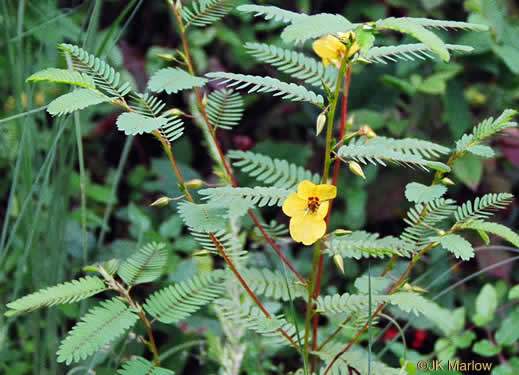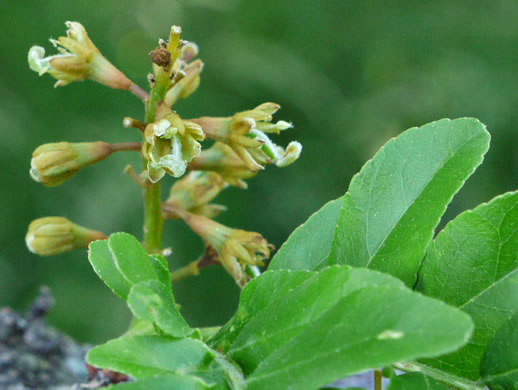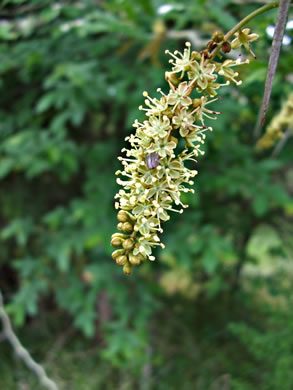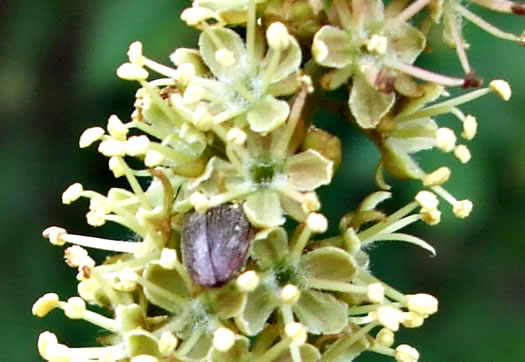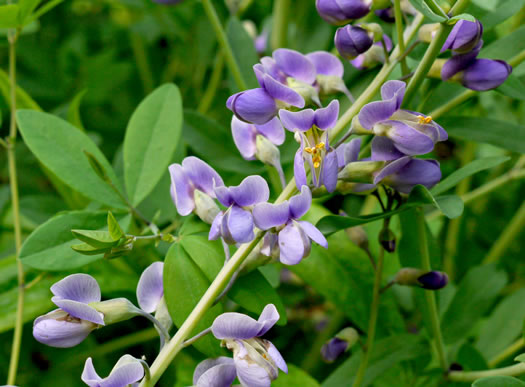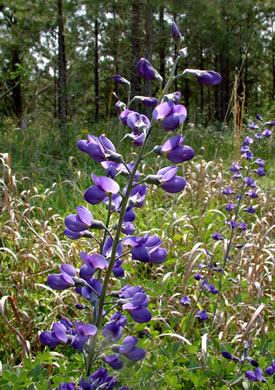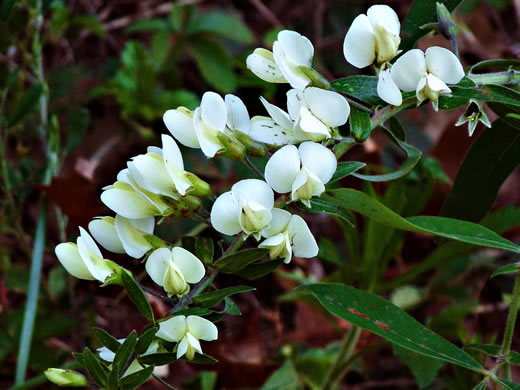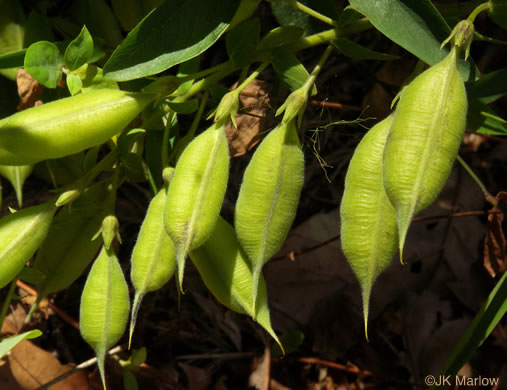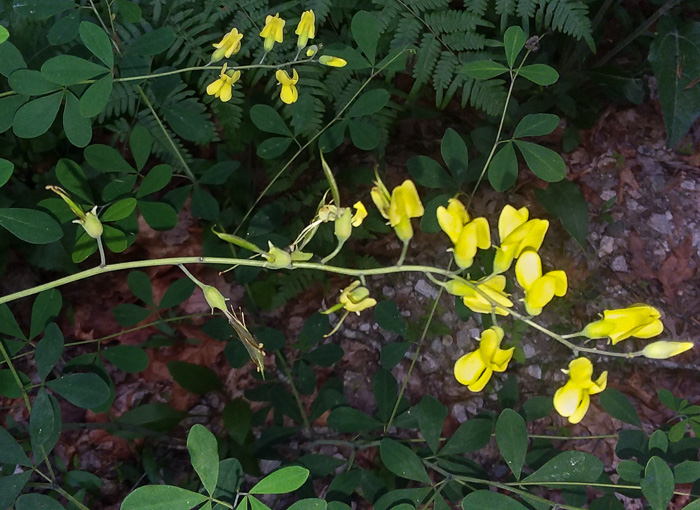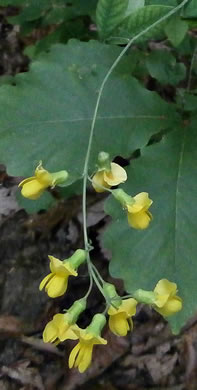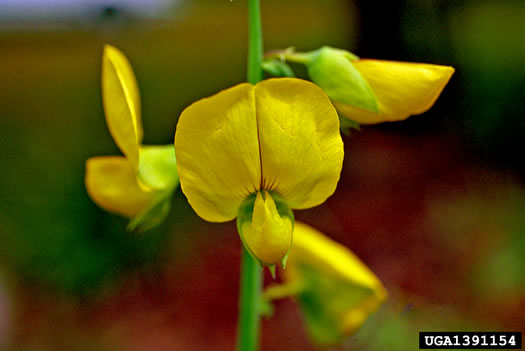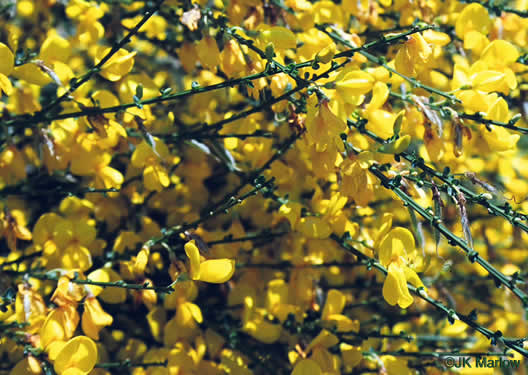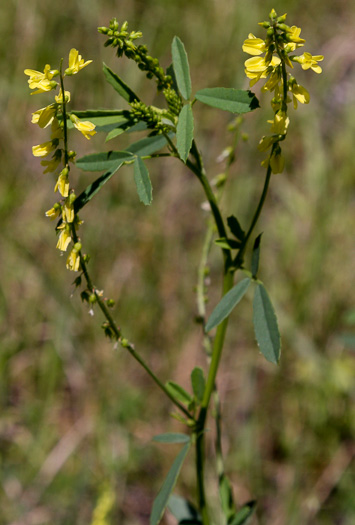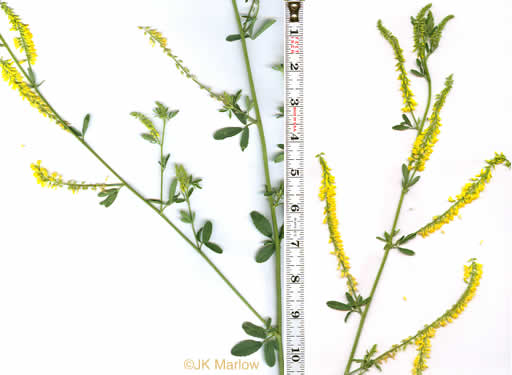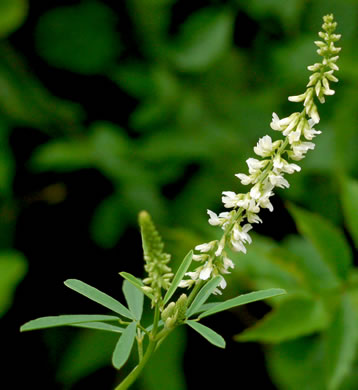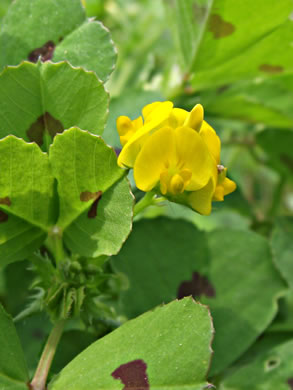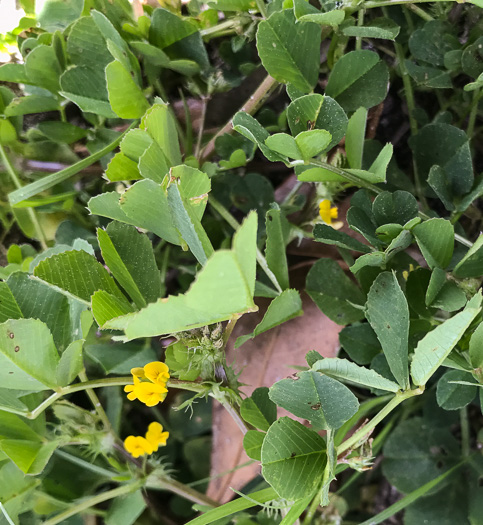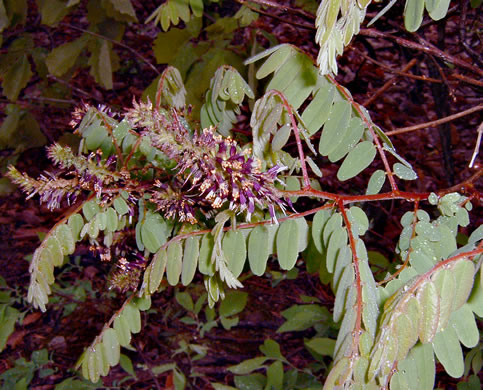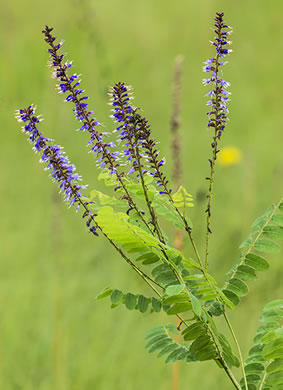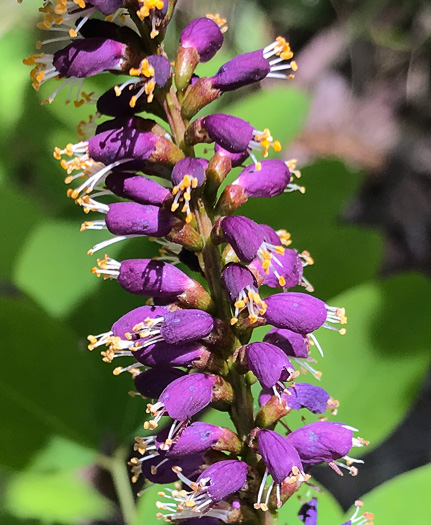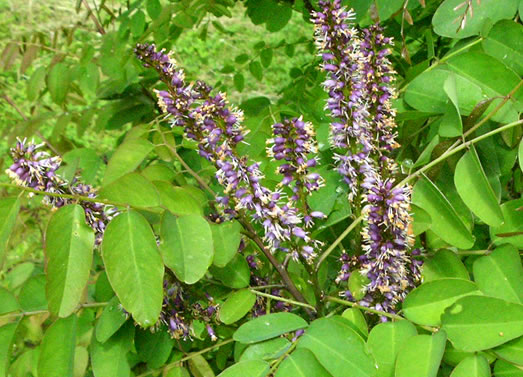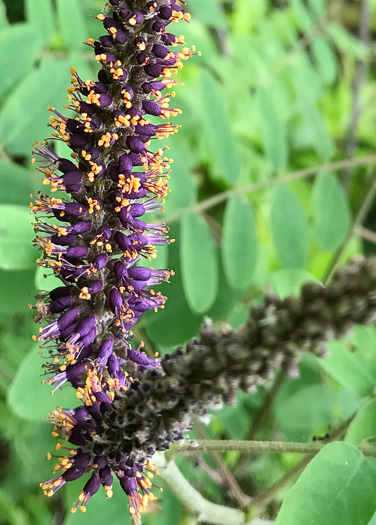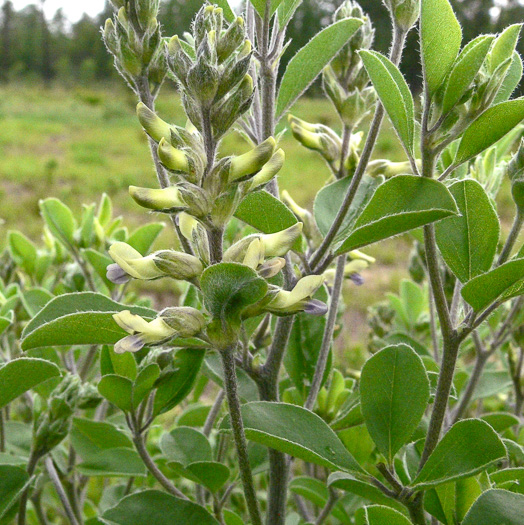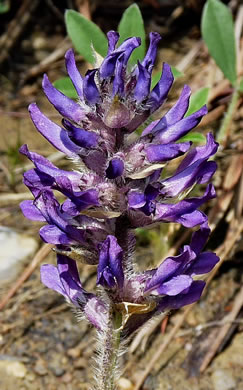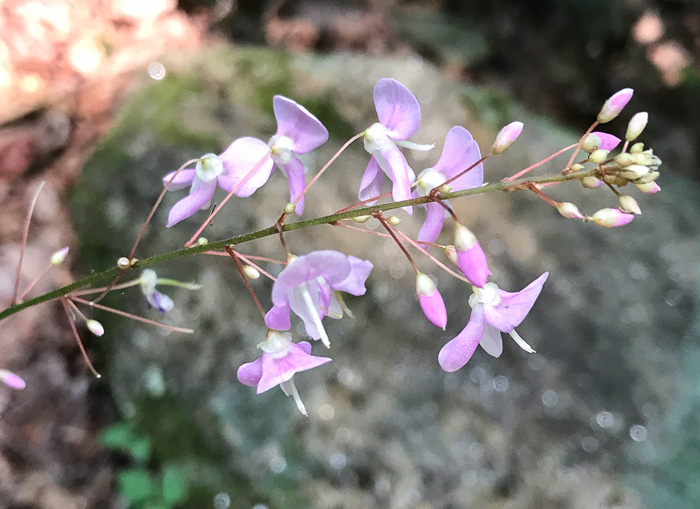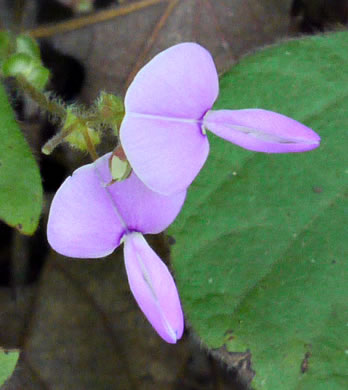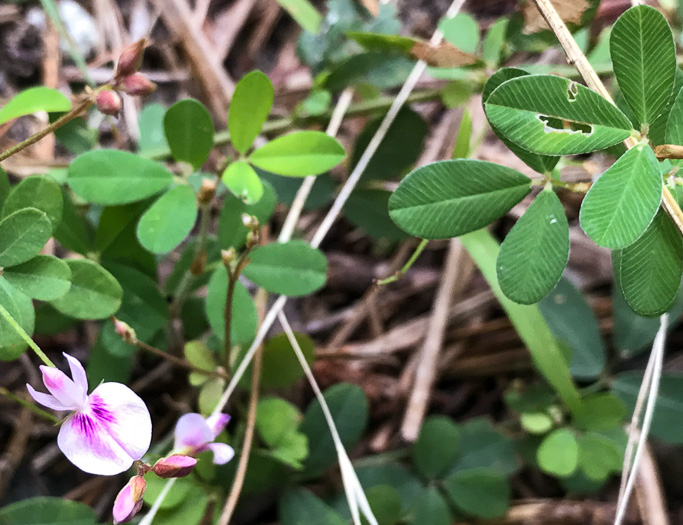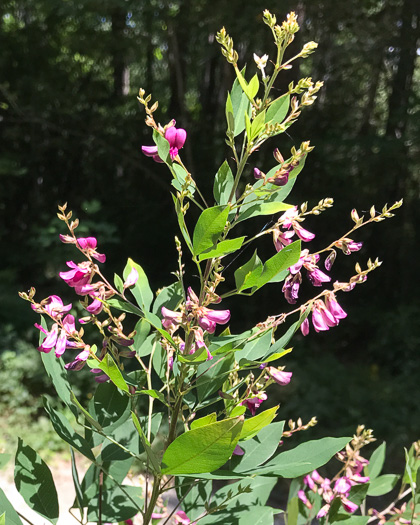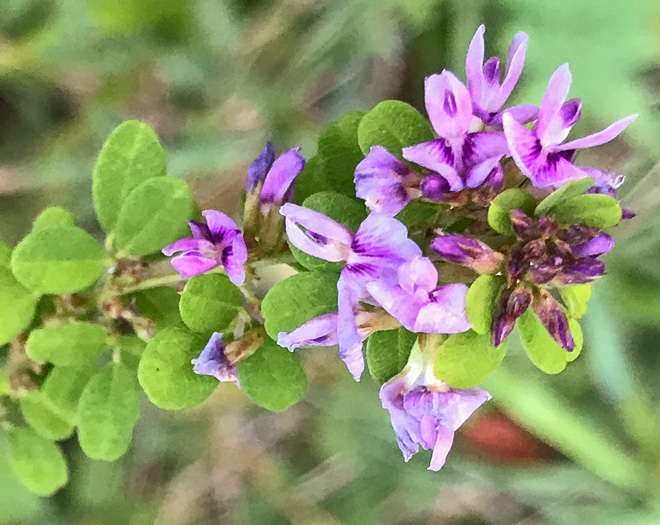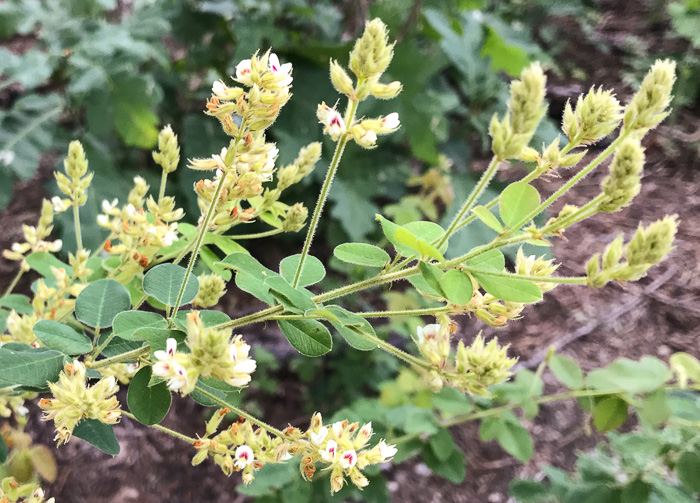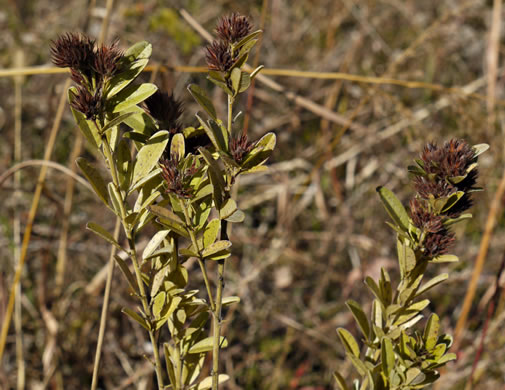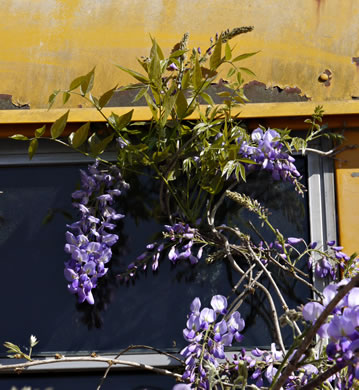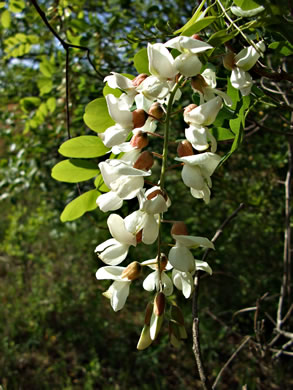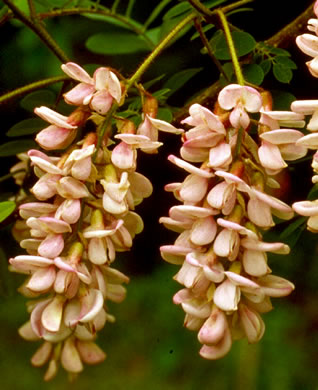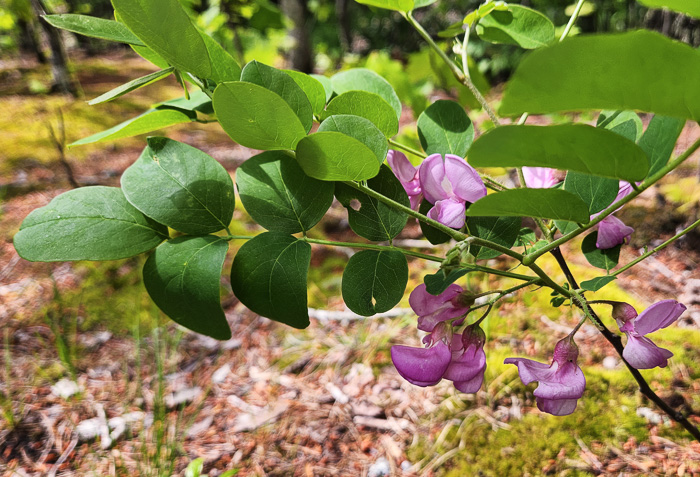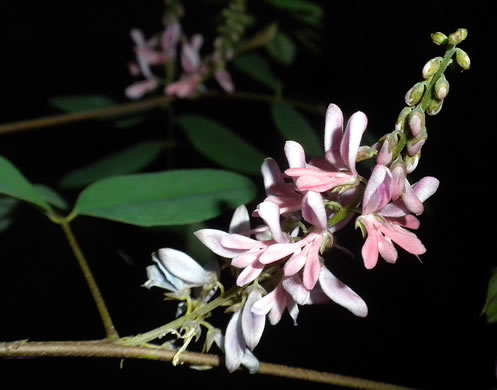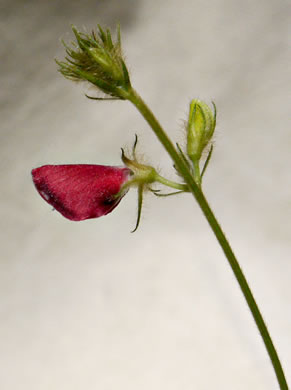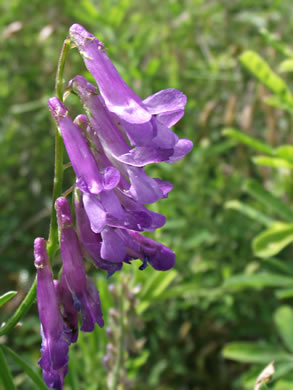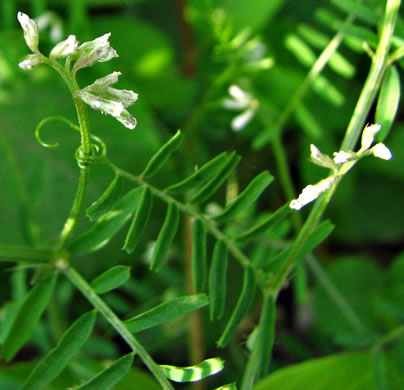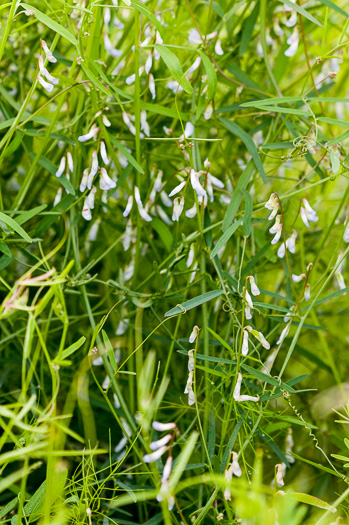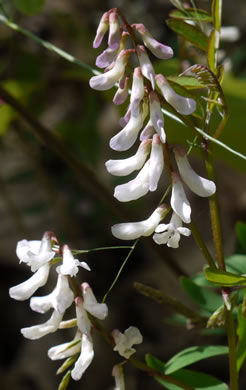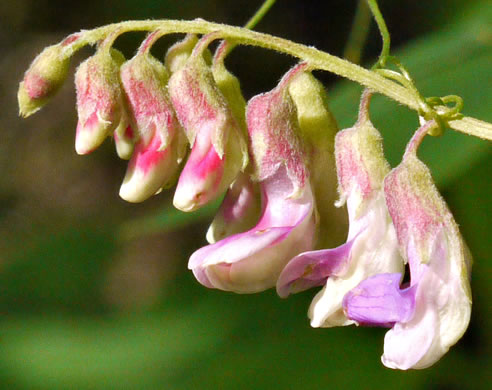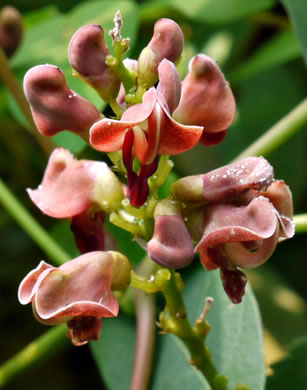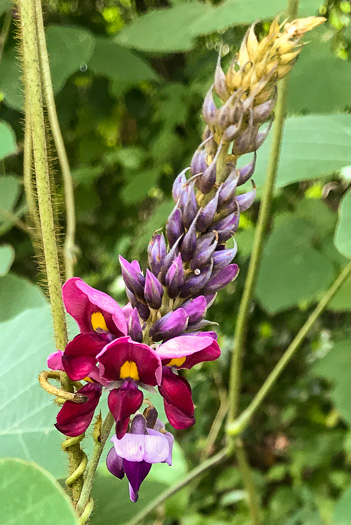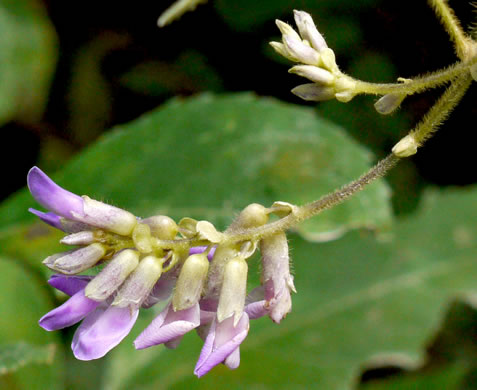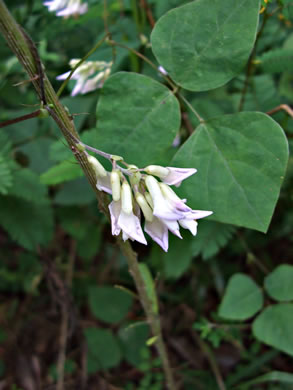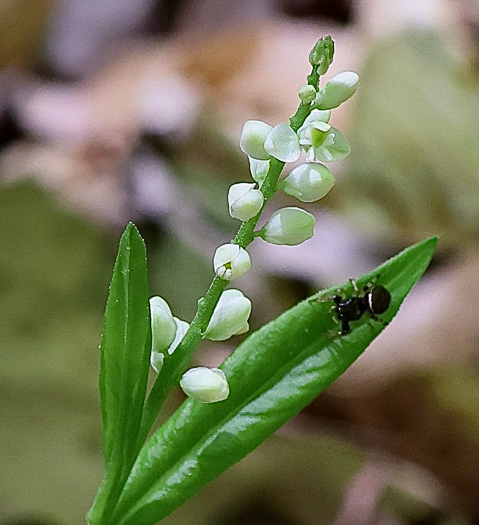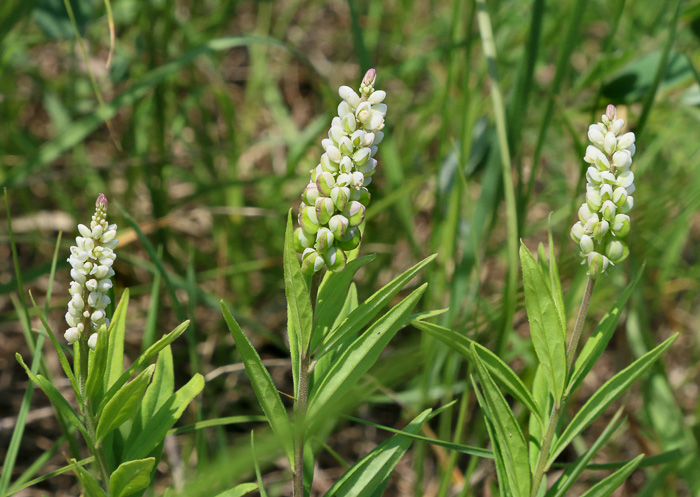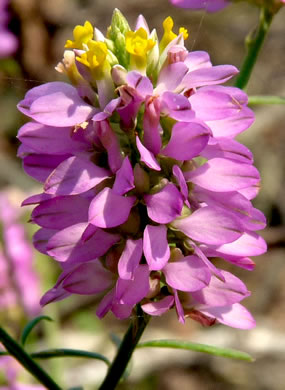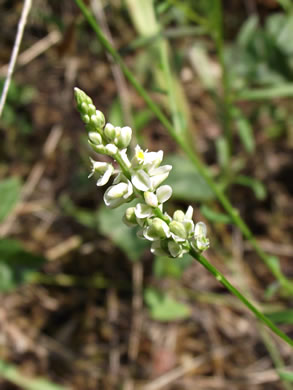Your search found 251 image(s) illustrating the term "raceme." For a written explanation, click on "raceme" in the Glossary.
PAGE 1 PAGE 2 PAGE 3 PAGE 4 PAGE 5
To see larger pictures, click or hover over the thumbnails.
To go to the plant's detail page, click its name.
 Common Partridge-pea,
Chamaecrista fasciculata var. fasciculata
Common Partridge-pea,
Chamaecrista fasciculata var. fasciculata
Short racemes of 1-6 flowers arise from the upper leaf axils, per Wildflowers of Tennessee (Carman, 2005).
 Sensitive Partridge-pea,
Chamaecrista nictitans var. nictitans
Sensitive Partridge-pea,
Chamaecrista nictitans var. nictitans
Flowers axillary, solitary or 2-3 borne in a tight raceme, per Vascular Flora of the Carolinas (Radford, Ahles, & Bell, 1968).
 Honey Locust,
Gleditsia triacanthos
Honey Locust,
Gleditsia triacanthos
Pistillate flowers in solitary racemes (fewer-fowered than staminate racemes), per Vascular Flora of the Carolinas (Radford, Ahles, & Bell, 1968).
 Honey Locust,
Gleditsia triacanthos
Honey Locust,
Gleditsia triacanthos
Staminate flowers numerous, in often fascicled racemes 5-10cm long, per Vascular Flora of the Carolinas (Radford, Ahles, & Bell, 1968).
 Honey Locust,
Gleditsia triacanthos
Honey Locust,
Gleditsia triacanthos
Flowers greenish-yellow, 1/4" long, clustered in compact racemes, per Native Trees of the Southeast, An Identification Guide (Kirkman, Brown, & Leopold, 2007).
 Tall Blue Wild Indigo,
Baptisia australis
Tall Blue Wild Indigo,
Baptisia australis
Pea-like flowers deep blue-violet, in a long raceme extending above leaves, per Wildflowers of Tennessee, the Ohio Valley, and the Southern Appalachians (Horn, Cathcart, Hemmerly, & Duhl, 2005).
 Eastern Prairie Blue Wild Indigo,
Baptisia aberrans
Eastern Prairie Blue Wild Indigo,
Baptisia aberrans
Flowers in terminal, erect racemes 10-40cm long, per Vascular Flora of the Carolinas (Radford, Ahles, & Bell, 1968).
 Creamy Wild Indigo,
Baptisia bracteata
Creamy Wild Indigo,
Baptisia bracteata
Flowers in drooping 1-sided racemes with persistent bracts, per Wildflowers of the Eastern United States (Duncan & Duncan, 1999).
 Creamy Wild Indigo,
Baptisia bracteata
Creamy Wild Indigo,
Baptisia bracteata
Flowers [& fruit] in drooping one-sided racemes, per Guide to the Wildflowers of SC, 1st ed. (Porcher & Rayner, 2001).
 Gopherweed,
Baptisia lanceolata
Gopherweed,
Baptisia lanceolata
Flowers about 1" long, borne in leaf axils or in short terminal racemes, per Atlantic Coastal Plain Wildflowers (Nelson, 2006).
 a hybrid Wild Indigo,
Baptisia ×serenae
a hybrid Wild Indigo,
Baptisia ×serenae
Raceme slender: calyx lobes shorter than tube, per Manual of the Southeastern Flora (JK Small, 1933).
 Ashleaf Golden-banner,
Thermopsis fraxinifolia
Ashleaf Golden-banner,
Thermopsis fraxinifolia
Raceme loosely flowered, per Leguminosae (Fabaceae), vol 3, part 2, Vascular flora of the southeastern United States (Isely, 1990).
 Showy Rattlebox,
Crotalaria spectabilis
Showy Rattlebox,
Crotalaria spectabilis
Flowers deep yellow, pea-like, borne in a showy many-flowered raceme, per Wildflowers of Tennessee, the Ohio Valley, and the Southern Appalachians (Horn, Cathcart, Hemmerly, & Duhl, 2005).
 Scotch Broom,
Cytisus scoparius
Scotch Broom,
Cytisus scoparius
Flowers bright yellow, in terminal racemes, per Weakley's Flora (2015).
 Small Melilot,
Melilotus indicus
Small Melilot,
Melilotus indicus
Flowers 2-3mm (vs M. officinalis 5-7mm), densely crowded in slender racemes, per Wildflowers of the Eastern United States (Duncan & Duncan, 1999).
 Yellow Sweetclover,
Melilotus officinalis
Yellow Sweetclover,
Melilotus officinalis
Inflorescence a slender, axillary, pedunculate, spike-like raceme, per Vascular Flora of the Carolinas (Radford, Ahles, & Bell, 1968).
 White Sweetclover,
Melilotus albus
White Sweetclover,
Melilotus albus
Flowers white, pea-like, 0.25" long, borne in narrow loose racemes, per Wildflowers of Tennessee, the Ohio Valley, and the Southern Appalachians (Horn, Cathcart, Hemmerly, & Duhl, 2005).
 Spotted Medick,
Medicago arabica
Spotted Medick,
Medicago arabica
Racemes typically 1-5 flowers. Peduncles 1-2.5cm. Petals yellow, 4-5mm long, per Vascular Flora of the Carolinas (Radford, Ahles, & Bell, 1968).
 Toothed Medick,
Medicago polymorpha
Toothed Medick,
Medicago polymorpha
Racemes capitate, 1-8 flowered. Peduncles 1-3cm. Petals yellow, 2.5-4mm long, per Vascular Flora of the Carolinas (Radford, Ahles, & Bell, 1968).
 Leadplant,
Amorpha herbacea var. herbacea
Leadplant,
Amorpha herbacea var. herbacea
Flowers are borne in clusters of conspicuous slender 4-12" racemes, per Atlantic Coastal Plain Wildflowers (Nelson, 2006).
 Piedmont Indigo-bush,
Amorpha schwerinii
Piedmont Indigo-bush,
Amorpha schwerinii
Calyx lobes approach, = or exceed length of calyx tube; racemes 3-8(15)cm long, per Weakley's Flora.
 Savanna Indigo-bush,
Amorpha confusa
Savanna Indigo-bush,
Amorpha confusa
The racemes are mostly panicled, (1)3-5(8) per flowering branch, per Weakley's Flora.
 Mountain Indigo-bush,
Amorpha glabra
Mountain Indigo-bush,
Amorpha glabra
Flowers borne in dense erect terminal racemes, per Woody Plants of the Blue Ridge (Lance).
 Mountain Indigo-bush,
Amorpha glabra
Mountain Indigo-bush,
Amorpha glabra
1-4 terminal racemes, (5)10-28cm long, per Vascular Flora of the Carolinas (Radford, Ahles, & Bell, 1968).
 False Indigo,
Amorpha fruticosa
False Indigo,
Amorpha fruticosa
Racemes dense, 7-15cm long, with violet-purple flowers 6-8mm long, per Native Shrubs and Woody Vines of the Southeast (Foote & Jones, 1989).
 Buckroot,
Pediomelum canescens
Buckroot,
Pediomelum canescens
Flowers in 1-2" racemes, 4-8 per raceme. The calyx is densely downy, per Wildflowers of the Sandhills Region (Sorrie, 2011).
 Nashville Breadroot,
Pediomelum subacaule
Nashville Breadroot,
Pediomelum subacaule
Blue-purple pea-like flowers borne in dense racemes about 3" long, per Wildflowers of Tennessee, the Ohio Valley, and the Southern Appalachians (Horn, Cathcart, Hemmerly, & Duhl, 2005).
 Naked Tick-trefoil,
Hylodesmum nudiflorum
Naked Tick-trefoil,
Hylodesmum nudiflorum
Rose-purple, pea-like flowers in a loose raceme on a leafless scape, per Wildflowers of Tennessee, the Ohio Valley, and the Southern Appalachians (Horn, Cathcart, Hemmerly, & Duhl, 2005).
 Roundleaf Tick-trefoil,
Desmodium rotundifolium
Roundleaf Tick-trefoil,
Desmodium rotundifolium
Erect, sparsely flowered racemes arise from the trailing stem, per Wildflowers of the Southern Mountains (Smith, 1998).
 Japanese-clover,
Kummerowia striata
Japanese-clover,
Kummerowia striata
Flowers solitary or 2-5 in spikelike axillary racemes, per Vascular Flora of the Carolinas (Radford, Ahles, & Bell, 1968).
 Bicolor Lespedeza,
Lespedeza bicolor
Bicolor Lespedeza,
Lespedeza bicolor
Inflorescence a paniculate cluster of individual racemes, per Vascular Flora of the Carolinas (Radford, Ahles, & Bell, 1968).
 Wand Lespedeza,
Lespedeza violacea
Wand Lespedeza,
Lespedeza violacea
Flowers in dense racemes. Keel petals usually shorter than the wing petals, per Vascular Flora of the Carolinas (Radford, Ahles, & Bell, 1968).
 Hairy Bush-clover,
Lespedeza hirta +
Hairy Bush-clover,
Lespedeza hirta +
Racemes on often-elongate peduncles equaling or longer than subtending leaves, per Vascular Flora of the Carolinas (Radford, Ahles, & Bell, 1968).
 Round-headed Lespedeza,
Lespedeza capitata
Round-headed Lespedeza,
Lespedeza capitata
Racemes numerous, mostly in upper axils, very dense, glomerate or spicate, per Vascular Flora of the Carolinas (Radford, Ahles, & Bell, 1968).
 American Wisteria,
Wisteria frutescens var. frutescens
American Wisteria,
Wisteria frutescens var. frutescens
Flowers borne in a compact raceme, 3-6" long, per Wildflowers of Tennessee, the Ohio Valley, and the Southern Appalachians (Horn, Cathcart, Hemmerly, & Duhl, 2005).
 Chinese Wisteria,
Wisteria sinensis
Chinese Wisteria,
Wisteria sinensis
Raceme to 33cm long; the 25-95 flowers opening nearly simultaneously, per Weakley's Flora (2020).
 Black Locust,
Robinia pseudoacacia
Black Locust,
Robinia pseudoacacia
Fragrant white flowers appear after leaves & dangle in racemes 4-6" long, per Native Trees of the Southeast, An Identification Guide (Kirkman, Brown, & Leopold, 2007).
 Clammy Locust,
Robinia viscosa
Clammy Locust,
Robinia viscosa
Racemes sometimes with some glandular pubescence, per Weakley's Flora (2015).
 Granite Dome Locust,
Robinia hartwigii
Granite Dome Locust,
Robinia hartwigii
Racemes with short-stalked glandular trichomes; petals roseate or whitish, per Vascular Flora of the Carolinas (Radford, Ahles, & Bell, 1968).
 Boynton's Locust,
Robinia hispida var. rosea
Boynton's Locust,
Robinia hispida var. rosea
Racemes and calyces may be glabrous, or may have fine nonglandular pubescence, or...
 Carolina Indigo,
Indigofera caroliniana
Carolina Indigo,
Indigofera caroliniana
Racemes pedunculate, axillary or terminal, w numerous loosely arranged flowers, per Vascular Flora of the Carolinas (Radford, Ahles, & Bell, 1968).
 West Indian Indigo,
Indigofera suffruticosa
West Indian Indigo,
Indigofera suffruticosa
Crimson to rust-red flowers grow in short, many-flowered racemes, per Indigofera suffruticosa, wild indigo FABACEAE - USDA FS (Francis).
 Spiked Hoary-pea,
Tephrosia spicata
Spiked Hoary-pea,
Tephrosia spicata
Few-flowered racemes at the ends of long slender axillary or terminal stalks, per Wildflowers of the Southern Mountains (Smith, 1998).
 Canada Milkvetch,
Astragalus canadensis var. canadensis
Canada Milkvetch,
Astragalus canadensis var. canadensis
The somewhat reflexed flowers are in long-peduncled axillary racemes, per Wild Flowers of NC, 2nd edition (Justice, Bell, & Lindsey, 2005).
 Smooth Vetch,
Vicia villosa var. glabrescens
Smooth Vetch,
Vicia villosa var. glabrescens
Racemes long-stalked, dense, one-sided, mostly with 5-15 blue flowers, per Wildflowers of Tennessee (Carman, 2005).
 Tiny Vetch,
Vicia hirsuta
Tiny Vetch,
Vicia hirsuta
Flowers white, 3-6 in raceme, each 2-3mm, per Forest Plants of the Southeast and Their Wildlife Uses (Miller & Miller, 2005).
 Sand Vetch,
Vicia acutifolia
Sand Vetch,
Vicia acutifolia
Racemes of 4-10, loosely clustered, often secund flowers; petals pale blue, per Vascular Flora of the Carolinas (Radford, Ahles, & Bell, 1968).
 Carolina Vetch,
Vicia caroliniana
Carolina Vetch,
Vicia caroliniana
Racemes of 7-20 loosely clustered, pale lavender to white flowers, per Vascular Flora of the Carolinas (Radford, Ahles, & Bell, 1968).
 Smooth Forest Pea,
Lathyrus venosus var. venosus
Smooth Forest Pea,
Lathyrus venosus var. venosus
Dense racemes of 10-20 pea-like flowers, per Wildflowers of Tennessee, the Ohio Valley, and the Southern Appalachians (Horn, Cathcart, Hemmerly, & Duhl, 2005).
 Sweet Pea,
Lathyrus odoratus
Sweet Pea,
Lathyrus odoratus
['Cupani'] Similar to L. latifolius, but has very few flowers per raceme, per Wildflowers of the Southern Mountains (Smith, 1998).
 American Groundnut,
Apios americana
American Groundnut,
Apios americana
Sweetly fragrant brown-purple flowers arise in racemes from leaf axils, per Wildflowers of Tennessee (Carman, 2005).
 American Groundnut,
Apios americana
American Groundnut,
Apios americana
Flowers 1/2" long, petals thick and brownish-purple, racemes dense & compact, per Wildflowers of the Southern Mountains (Smith, 1998).
 Kudzu,
Pueraria montana var. lobata
Kudzu,
Pueraria montana var. lobata
Flowers on bracted short hairy pedicels, opening from base of raceme to top, per Forest Plants of the Southeast and Their Wildlife Uses (Miller & Miller, 2005).
 American Hog-peanut,
Amphicarpaea bracteata +
American Hog-peanut,
Amphicarpaea bracteata +
Racemes from upper axils nod on slender peduncles mostly 1-6cm long, per Vascular Flora of the Carolinas (Radford, Ahles, & Bell, 1968).
 American Hog-peanut,
Amphicarpaea bracteata +
American Hog-peanut,
Amphicarpaea bracteata +
Racemes of 1-17 petaliferous flowers, per Vascular Flora of the Carolinas (Radford, Ahles, & Bell, 1968).
 Senega Snakeroot,
Senega officinalis +
Senega Snakeroot,
Senega officinalis +
Flowers in a spike-like terminal raceme, white tinged w pink or green, < 1/4" long, often closed, per Wildflowers of the Atlantic Southeast (Cotterman, Waitt, & Weakley, 2019).
 Senega Snakeroot,
Senega officinalis +
Senega Snakeroot,
Senega officinalis +
Long, narrow, uninterrupted racemes of white or greenish flowers, per Wildflowers of the Southern Mountains (Smith, 1998).
 Curtiss's Milkwort,
Senega curtissii
Curtiss's Milkwort,
Senega curtissii
Flowers occur in a compact raceme with buds forming a small cone on top, per Wildflowers of Tennessee (Carman, 2005).
 Curtiss's Milkwort,
Senega curtissii
Curtiss's Milkwort,
Senega curtissii
Flowers in a dense cylindric raceme, a compact head similar to clover, per Wildflowers of Tennessee, the Ohio Valley, and the Southern Appalachians (Horn, Cathcart, Hemmerly, & Duhl, 2005).
 Whorled Milkwort,
Senega verticillata +
Whorled Milkwort,
Senega verticillata +
Racemes 3-6mm broad, per Vascular Flora of the Carolinas (Radford, Ahles, & Bell, 1968).

